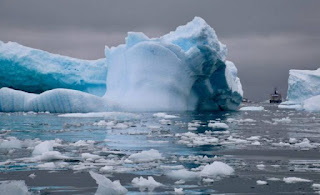Methane release rapidly increases in the wake of the melting ice sheets

The ice age is not easy to define. It may seem plausible that an ice age represents a frozen planet, but the truth is often more nuanced than this. A glacial age consists of continuous glaciers and disintegrations, in which the ice sheets tremble with the changing climate. These giants are constantly waxing and waning, exerting and lifting pressure from the sea level.
Several studies also show that the most recent desalination, the Holocene of Barents C (about 21ka – 15ka ago), has had a major impact on the release of methane in water.
One of the most recent studies in geology looks back even at 125 000 years ago, and contributes to the conclusion: melting ice sheets of the Arctic leads to the release of the powerful greenhouse gas methane from the ocean floor.
“In our study, we extend the geological history of the last archaelogic methane release, which is the last Iglicial, so-called amian period. We have found that the similarity between the events of both the holocene and the emime is a common driver of degeneration. Advocates.
Episodic release of geological methane – the retreat of the ice sheet. “Says researcher Pierre-Antoine Desandier, who as a postdoctoral fellow at the Cage Center for Arctic Gas Hydrate Environment and Climate at UIT Arctic University in Norway Studied.
Watching thousands of years of methane drop into small circles
The study is based on measurements of various isotopes found in sediment cores collected from the Arctic Ocean. Isotopes are adaptations of chemical elements, such as carbon and oxygen, in this case. Different isotopes of the same element have different weights and interact with other chemical elements in the atmosphere in specific ways.
This means that the structure of some isotopes is related to environmental changes – such as temperature or the amount of methane in the water column or within the sediment.
The isotopes are carried up and stored in small organisms called foramifera and thus stored in sediment for thousands of years as the small organisms die. In addition, if methane is left for longer, stored shells receive an overgrowth of carbonates that can also be tested for isotopes by themselves.
“Isotopic records showed that as the ice sheet melted and the pressure on the seabed decreased during the amion, methane was released into violent sprays, slow seepage, or a combination of both. As long as ice Until thousands of years later, methane emissions had stabilized. “Says Desandier.
Arctic methane reservoirs contain gas hydrates and free gases. Gas hydrates are solids, usually methane gas, frozen in a cage with water, and susceptible to pressure and temperature changes at sea. These reservoirs are potentially large enough to increase atmospheric methane concentrations if released during glacial and ice melting.
The study of geology corroborates the hypothesis that the release of this greenhouse gas is strongly correlated with the melting of the ice sheet. It is an example of the past that shows what the future can be.
“The current acceleration of the Greenlands ice melt is an analog of our model. We believe these methane from below and near is likely to be released in the future.” Says dassandier
Methane emissions are a major contributor to the increasing concentration of greenhouse gases in the Earth’s atmosphere, and are responsible for up to one-third of global warming. During 2019, approximately 60% (360 million tonnes) of globally released methane was from human activities, while natural sources contributed about 40% (230 million tonnes).
How precarious the methane ultimately made the atmosphere during the amoean and Holocene degeneration. Part of the problem with quantifying it is microorganism communities that live on the seashore and in the water and use methane to survive.
But both of those previous disruptions occurred over thousands of years, while the current withdrawal of ice sheets is unprecedentedly rapid according to geological records.
“Projections of future climate change must certainly include the release of methane in the wake of receding ice sheets. The past can be used to better inform the future.”
